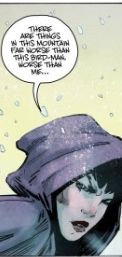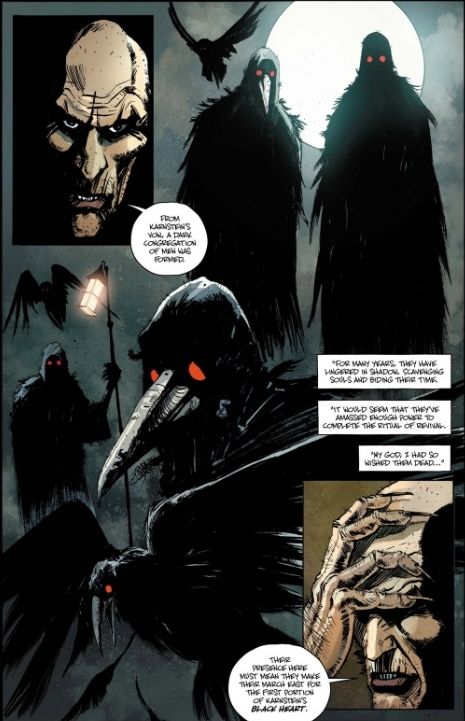Posted in: Comics, Digital, Recent Updates | Tagged: Chris Mooneyham, Rachel Deering
Anathema, From One To Three Of Six
Alasdair Stuart writes;

Then, in the space of a few pages, Rachel Deering's script turns everything we know on its head. The woman being burned isn't a witch, she's being punished for being in love with another woman, Mercy, who is watching, horrified, from the woods. The Priest overseeing the execution is Sarah's father and as if that wasn't enough, at the last moment, something impossible happens. Sarah's soul is ripped from her body by a creature wearing the shape of a bird, and carried off into the night. In the space of half a dozen pages Mercy is outcast from her life, from society, witnesses the love of her life being killed by her own family and then falling victim to something even more inhuman that that.
As openings to horror stories go, you can't get much better than that.
Deering's script thrives on this sort of subversion and all three of the issues published to date not only embrace horror staples but continually find new ways to look at them. Mercy herself is a perfect example of this by simple dint of her gender. This is a horror story made out of familiar pieces but Mercy's presence means you're constantly looking at them in a different way. There's not a shred of the traditional horror female lead to her, no sense of her being seconds away from falling over or screaming ineffectually as something blasphemous lumbers towards her. Mercy is a fiercely determined, focused heroine who decides there's one thing she wants to do; save Sarah. The obstacles between her and her objective are staggering and there isn't one of them that Mercy doesn't look straight in the eye as she hacks her way through it. She sacrifices everything, including her humanity, for the battle and the fact that everything she does comes from a combination of love and vengeance only makes her quest more personal and gives the book more weight.

Deering's script continually refuses to take the easy way out and what Mercy gains in abilities she loses in communication. Issue 2's brutal, almost balletic fight concludes with her being mistaken for the creature responsible and attacked by a local farmer, despite having saved his daughter. She fights her instincts to retaliate and…loses. She kills him and, unnoticed, the little girl follows her into the woods. This idea of balance, that for every action there's a consequence, is one that lies at the heart of the book and, in particular, it's villain. It would have been very easy for Deering to set up a relatively off the peg supernatural horror but she's far too good a writer for that. Karnstein is a former Pestarzt or plague doctor who lost his faith in everything when his family were taken by the black death. Turning to the dark arts, he became sustained by the torture and murder of the innocent which, in turn, led to a visit from the Templars. Karnstein's heart was quartered, each section buried somewhere different and, in the tradition of great monsters, proceeded to corrupt the places where it had been buried, slowly bending the living nearby to his will. As the book opens, Karnstein's forces are on the rise and Sarah's soul is part of the energies that will bring him to life. Mercy isn't just fighting the supernatural, she's fighting a man who was in almost exactly the same situation as she was, but was consumed by the darkness instead of bending it to his will. There's tragedy wrapped up in both of them, but also a sense of balance which focuses the emotional heart of the book to a fine, presumably silver, tip. This is personal, for both of them, and that means when they finally clash, it's going to be truly bloody.This is really smart writing, Deering not only using her (as yet unseen) villain as a dark mirror to her heroine, but also to show just how close to the line Mercy is walking. She's very close to making the same call Karnstein did, and as the book progresses it seems that that may be the plan. As Mercy tracks down and kills the creatures that have formed around the four piece of Karnstein's heart, it's becoming unclear whether she's playing the game or is just a piece on the board.
Three issues in what is clear that Anathema is one of the smartest horror books on the market right now. It's also one of the best looking, with the book's art as integral to setting the mood as Deering's script. The first two issues feature art by Chris Mooneyham and colors by Fares Maese are rooted in those old Hammer horror woods, everything drenched in black, blue and other worldly red.

There's some astonishing work in these two issues, especially the reveal on Karnstein's raven-men seen above and Mercy's first transformation, tearing its way across a two page splash and shattering panels as it goes. Filled with inhuman shadows and sudden violence it's the perfect art for Deering's story. Welsey St Clare takes over art, and Ian Herring takes colours for the third issue. St Clare has a more expressive, character-driven style and Herring's colors are brighter but more subdued. The transition works very well, especially as issue 3 sees Mercy make her way out into the mountains. The art suits the colder, more open environments and the climactic fight is exactly as savage as the ones Mooneyham depicts. This is one of those books where the art and the script constantly work together, instead of just flying in loose formation, and the tone and atmosphere of each issue is massively helped as a result.
Anathema is one of the best horror books on the market right now, and I'm completely unsurprised it was chosen as one of the standard bearers for Comixology Submit. From the very first page you can tell this is a book with a clear vision of where it's going, and a script and art that constantly work with, instead of pulling against, one another. Filled with cold, black woods, barely human monstrosities and moments of almost Conan-like action, it's a full blooded, teeth-bared comic that's getting better every issue and absolutely deserves your attention.
Issues 1-3 of Anathema are available through Comixlogy now, priced $1.99 each.













